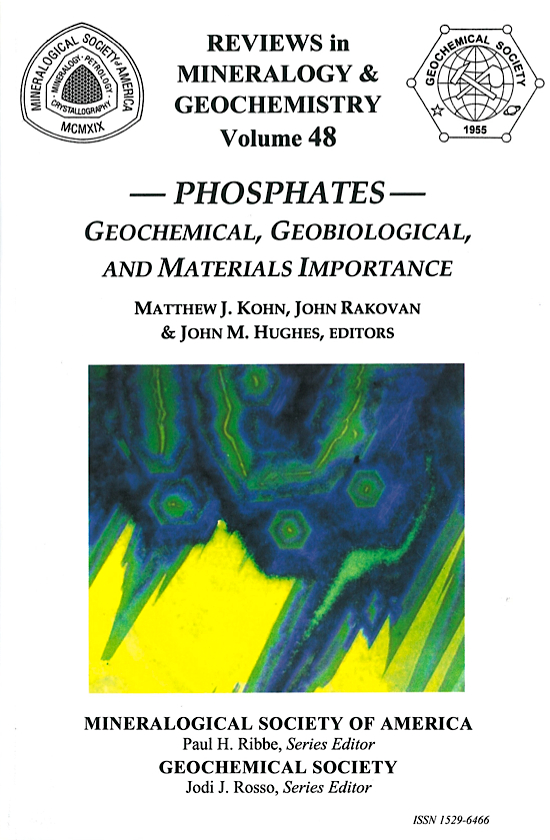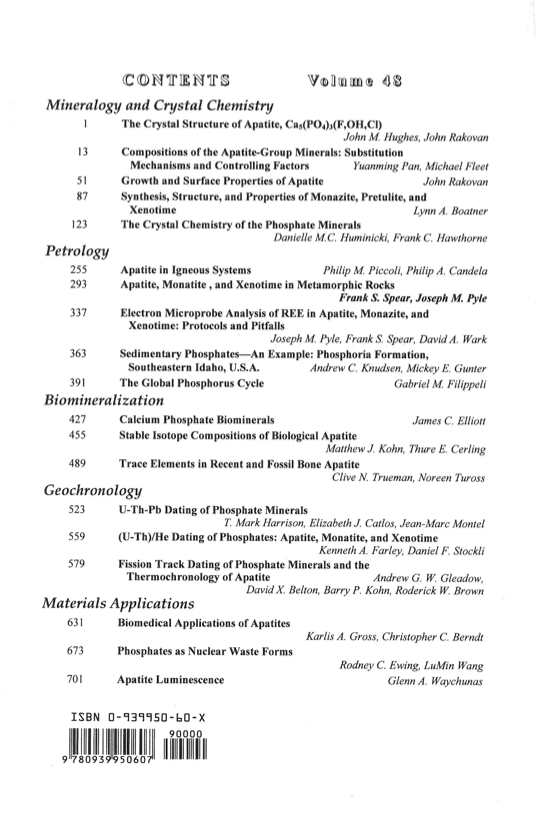

Mineralogical Society of America, Founded December 30, 1919
Order Publications Online (25% discount for MSA, CMS and GS members, except shipping)
MinPubs.org Pay-Per-View GeoScienceWorld Pay-Per-View


2002 i-xvi + 742 pages. ISBN 0-939950-60-X; ISBN13 978-0-939950-60-7
Several years ago, John Rakovan and John Hughes (colleagues at Miami of Ohio), and later Matt Kohn (at South Carolina), separately proposed short courses on phosphate minerals to the Council of the Mineralogical Society of America (MSA). Council suggested that they join forces. Thus this volume, Phosphates: Geochemical, Geobiological, and Materials Importance, was organized. It was prepared in advance of a short course of the same title, sponsored by MSA and presented at Golden, Colorado, October 25-27.
We are pleased to present this volume entitled Phosphates: Geochemical, Geobiological and Materials Importance. Phosphate minerals are an integral component of geological and biological systems. They are found in virtually all rocks, are the major structural component of vertebrates, and when dissolved are critical for biological activity. This volume represents the work of many authors whose research illustrates how the unique chemical and physical behavior of phosphate minerals permits a wide range of applications that encompasses phosphate mineralogy, petrology, biomineralization, geochronology, and materials science. While diverse, these fields are all linked structurally, crystal-chemically and geochemically. As geoscientists turn their attention to the intersection of the biological, geological, and material science realms, there is no group of compounds more germane than the phosphates.
The chapters of this book are grouped into five topics: Mineralogy and Crystal Chemistry, Petrology, Biomineralization, Geochronology, and Materials Applications.
In the first section, three chapters are devoted to mineralogical aspects of apatite, a phase with both inorganic and organic origins, the most abundant phosphate mineral on earth, and the main mineral phase in the human body. Monazite and xenotime are highlighted in a fourth chapter, which includes their potential use as solid-state radioactive waste repositories. The Mineralogy and Crystal Chemistry section concludes with a detailed examination of the crystal chemistry of 244 other naturally-occurring phosphate phases and a listing of an additional 126 minerals.
In the Petrology section, three chapters detail the igneous, metamorphic, and sedimentary aspects of phosphate minerals. A fourth chapter provides a close look at analyzing phosphates for major, minor, and trace elements using the electron microprobe. A final chapter treats the global geochemical cycling of phosphate, a topic of intense, current geochemical interest.
The Biomineralization section begins with a summary of the current state of research on bone, dentin and enamel phosphates, a topic that crosses disciplines that include mineralogical, medical, and dental research. The following two chapters treat the stable isotope and trace element compositions of modern and fossil biogenic phosphates, with applications to paleontology, paleoclimatology, and paleoecology.
The Geochronology section focuses principally on apatite and monazite for U-ThPb, (U- Th)/He, and fission-track age determinations; it covers both classical geochronologic techniques as well as recent developments.
The final section-Materials Applications-highlights how phosphate phases play key roles in fields such as optics, luminescence, medical engineering and prosthetics, and engineering of radionuclide repositories. These chapters provide a glimpse of the use of natural phases in engineering and biomedical applications and illustrate fruitful areas of future research in geochemical, geobiological and materials science. We hope all chapters in this volume encourage researchers to expand their work on all aspects of natural and synthetic phosphate compounds.
Matthew L. Kohn. Columbia, South Carolina, USA
John Rakovan and John M. Hughes, Oxford, Ohio, USA
August 17, 2002
Title Page
p. i
Copyright
p. ii
Dedication
p. iii - iv
Foreword & Preface
p. v - vi
Table of Contents
p. vii - xvi
Chapter 1. The Crystal Structure of Apatite, Ca5(PO4)3(F,OH,Cl)
by John M. Hughes and John Rakovan, p. 1 - 12
Chapter 2. Compositions of the Apatite-Group Minerals: Substitution Mechanisms and Controlling Factors
by Yuanming Pana and Michael E. Fleet, p. 13 - 50
Chapter 3. Growth and Surface Properties of Apatite
by John Rakovan, p. 51 - 86
Chapter 4. Synthesis, Structure and Properties of Monazite, Pretulite, and Xenotime
by Lynn A. Boatner, p. 87 - 122
Chapter 5. The Crystal Chemistry of the Phosphate Minerals
by Danielle M.C. Huminicki and Frank C. Hawthorne, p. 123 - 254
Chapter 6. Apatite in Igneous Systems
by Philip M. Piccoli and Philip A. Candela, p. 255 - 292
Chapter 7. Apatite, Monazite, and Xenotine in Metamorphic Rocks
by Frank S. Spear and Joseph M. Pyle, p. 293 - 336
Chapter 8. Electron Microprobe Analysis of REE in Apatite, Monazite and Xenotime: Protocols and Pitfalls
by Joseph M. Pyle, Frank S. Spear, and David A. Wark, p. 337 - 362
Chapter 9. Sedimentary Phosphorites - An Example: Phosphoria Formation, Southeastern Idaho, U.S.A
by Andrew C. Knudsen and Mickey E. Gunter, p. 363 - 390
Chapter 10. The Global Phosphorus Cycle
by Gabriel M. Filippelli, p. 391 - 426
Chapter 11. Calcium Phosphate Biominerals
by James C. Elliott, p. 427 - 454
Chapter 12. Stable Isotope Composition of Biological Apatite
by Matthew J. Kohn and Thure E. Cerling, p. 455 - 488
Chapter 13. Trace Elements in Recent and Fossil Bone Apatite
by Clive N. Trueman and Noreen Tuross, p. 489 - 522
Chapter 14. U-TH-Pb Dating of Phosphate Minerals
by T. Mark Harrison, Elizabeth J. Catlos, and Jean-Marc Montel, p. 523 - 558
Chapter 15. (U-Th)/He Dating of Phosphates: Apatite, Monazite, and Xenotime
by Kenneth A. Farley and Daniel F. Stockli, p. 559 - 578
Chapter 16. Fission Track Dating of Phosphate Minerals and the Thermochronology of Apatite
by Andrew J.W. Gleadow, David X. Belton, Barry P. Kohn, and Roderick W. Brown, p. 579 - 630
Chapter 17. Biomedical Application of Apatites
by Karlis A. Gross and Christopher C. Berndt, p. 631 - 672
Chapter 18. Phosphates as Nuclear Waste Forms
by Rodney C. Ewing and LuMin Wang, p. 673 - 700
Chapter 19. Apatite Luminescence
by Glenn A. Waychuna, p. 701 - 742